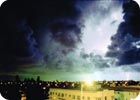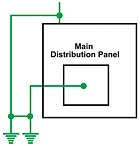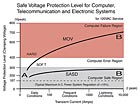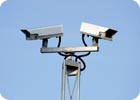Ground Yourself for Power Quality

Lightening can strike, and more than once. As security equipment becomes more electronically sophisticated, they demand a higher quality electrical environment to ensure optimal performance and uninterrupted operation.
Reliable operation of security systems is essential to protect company assets and ensure human safety. Episodic equipment malfunctions plague security systems and compromise system integrity. These malfunctions can be related to the power quality environment. As data and communication equipment become more electronically sophisticated they demand a higher quality electrical environment to ensure optimal performance and uninterrupted operation.
To resolve common power quality problems that can cause equipment malfunction and damage, it is crucial to understand the electrical sensitivity of various elements of a security system, best practices for a proper grounding system, and fundamentals of quality surge protection devices. Security Magazine thanks Transtector for the technical information in this article.
THREATS
Several sources cause changes in the characteristics of the power supply to the components of a security system, including:- Lightning activity
- Utility grid switching
- Utility power factor correction
- Start-up or shut-down of equipment within a facility
Equipment malfunction, damage and destruction can be avoided through the following:
- Implementing a single-point grounding system
- Following the NEC (National Electric Code) when installing the safety ground and grounding electrode systems
- Following the use of properly designed and appropriate integration of SPDs (surge protection devices)
SENSITIVE ELEMENTS OF A SECURITY SYSTEM
Visual surveillance, access control, storage of surveillance and access data, intruder detection and monitoring and notification equipment are all components of security systems. All are highly sensitive to poor power quality. These components are often on long cable runs located both in and outdoors. Surges can follow these cables back into a facility, and destroy expensive equipment or cause other hazardous situations.ACCESS CONTROL SYSTEMS
From high-security keyways and proximity card readers to biometrics, the levels of access and security can be adapted to site needs. Most large organizations use some level of electronic access control, with either magnetic stripe or proximity technology. Biometric products such as retinal scan, fingerprint or palm readers can provide higher levels of secure access to network operations and R&D labs. Each subsystem presents a unique set of grounding challenges.When the access control mechanism is located outdoors, it is typically mounted on a cement pad and surrounded by asphalt. It may be integrated with an electronic gate controller. All system components should be protected with SPDs and be properly grounded. Adequate grounding includes a buried site ground ring, or referencing back to the original neutral-ground bond in the building or the secondary neutral-ground bond of an associated step-down or isolation transformer.
Typically, a magnetic loop detector and underground burial loop is installed to ensure that the door or gate closes immediately after the vehicle has passed. The buried wire coil loop, sensing the metal of a passing vehicle, sends a signal to close the door or gate when the vehicle clears the opening. Any nearby lightning strike can induce a current surge onto this buried coil, and can travel back to the gate controller. Hence, electronic access control gate equipment, including the motor controller, should be protected by a SPD and properly grounded.

It’s critical to direct the majority of a lightning discharge’s current upon a building into the earth away its entrance grounding system.
VIDEO SURVEILLANCE SYSTEMS
These systems can incorporate digital cameras, monitors and storage and have become ubiquitous. Horizontal bars, a result of load unbalance in 60 cycle power distribution in the vicinity of a security video system, are a common problem for technicians. This anomaly is caused by a cross-over between the flow of AC power and the security video signal. This happens when there is a common point of connection (system ground) between the security video system and utility company.Complex systems that include multiple monitor locations, or camera cables connected through coaxial “patch panels,” tend to have severe 60 cycle interference. In these cases, there are numerous variables to consider when deciding upon a solution. The solution should always include a single point ground for the system.
This grounding point would normally be at the equipment hub or monitoring location. A security video network can have cameras located in numerous locations within buildings and outdoors mounted on buildings and poles. In applications with cameras mounted to metal buildings, numerous instances of damage to cameras and digital video recorders have been documented.
To mitigate this problem, your staff or your systems integrator should connect an isolation transformer at each point in the system where additional grounds are attached (grounded cameras, lightning arresters, patch panels, required coaxial cable grounds and any other possible source of grounding). Cameras mounted outside on tall poles also need to be protected by SPDs with effective dedicated grounds and optional air terminals.
Technicians, when installing outdoor cameras, often error through attempting to isolate the camera by mounting it on an insulating pad. This method is ineffective because a lightning surge, looking for the quickest path to ground, will frequently arc over from the building to the camera housing. Another common mistake is to bond the ground wire to steel on the building; however, if the steel beams are not properly bonded and tied to the ground ring, an isolated bond is not established.
A SPD to protect the power and data lines should be installed and be grounded locally. In this high frequency lightning event, an SPD is needed to stop current from reaching both equipment within the building and the ground loop. Proper equipment operation is frequently disrupted by improperly grounded cable shields. Shields are intended to block AC and high frequency fields. Low frequency power distributions that run in parallel can add noise or hum into low amplitude signal circuits; high frequency fields can alter data if there are transmitters in the area. Because of differing AC potentials in the soil an equalizing AC current can exist upon a shield.
This happens when the shield is grounded at more than one and causes unwanted noise to be introduced into the signal circuit.
INTRUDER DETECTION SYSTEMS
A properly designed intrusion detection system identifies when and where an intruder first enters a facility and pinpoints their current location. Heat and motion detectors are commonly used within buildings to detect intruders. Airports, harbors, nuclear power plants, pipelines and other critical infrastructure sites require reliable outdoor surveillance capabilities for intruder detection.Today, many sites are introducing Millimeter Wave Perimeter Security Radar to aid in detection of targets in poor visibility environments. It is obvious that these highly sensitive and costly technologies require installation of grounding and SPDs.
REMOTE SITE RADIO LINKS
Many enterprises with multiple facilities have integrated security systems. Remote sites networked via phone or radio link need RF surge protection on the antenna feed. Surge protection on AC/DC power supplies for rack equipment is also need. Once again, a single point grounding system is essential for proper trouble free operation.LIGHTNING PROTECTION SYSTEM GROUND
NFPA 780 of the NEC’s NFPA 70 (National Lightning Protection Code) requires a separate physical lightning protection (air terminal) earth ground electrode be bonded to the main entrance grounding electrode system. Its purpose is to direct the majority of a lightning discharge’s current upon a building into the earth away its entrance grounding system; thereby, significantly reducing the lightning current into the building electrical grounding system. Bonding of the two grounded systems as required maintains a reasonable degree of touch safety during the lightning event.SINGLE-POINT GROUNDING
Referencing individual equipment to earth (grounding) at different points creates safety and damage hazards.The earth is a very poor conductor; therefore, steady state and momentary voltage differences exist in the ground. The security system components are linked by control and communication cables with various voltages. If each component connects to the ground at different points, these voltage differences can cause equipment downtime and pose a safety threat. A single-point grounding system, where all references to the ground come to one main ground in the facility before referencing the earth is essential to all facilities.
In most AC installations, individual grounds are referenced back to the building’s original neutral-ground or a secondary neutral ground bond of an associated step-down or isolation transformer. In DC power applications single-point grounding is accomplished by using a master ground bar, such as a large piece of copper.

Concerning suppression technologies, there are MOVs (metal oxide varistors) and SASDs (silicon avalanche suppressor diodes). Most SPDs are MOV, SASD or a combination of SASD/MOV. Selection of one suppressor technology over another involves costing, maintenance and equipment sensitivity concerns.
GROUNDING TECHNIQUES
The NEC allows a single-point grounding system to be connected to the earth in seven different ways. The two most common are rod and pipe electrodes and ring ground. The other legal, but much less prevalent are:- Concrete-encased electrode (metal bars encased in concrete, buried in the earth)
- Grounded metal building frame
- Plate electrodes (metal plates buried in the earth for a larger surface area)
- Supplemental metal underground water pipe (this can be used as a secondary or third connection to the earth but is not legal as an individual means of grounding)
- Underground local metal structures (ex: gas piping)
If NEC is followed, all earth ground references are directly bonded to the original neutral-ground bond at the building entrance. This safety measure prevents a person touching a connected component from harm. A person would be harmed if contacting one component connected to an independent earth ground rod and another component connected to the main building ground system; especially during lightning events or fault conditions. Remember, the main reason for connecting an electrical distribution system to the earth is for touch safety. Driving extra rods (multiple grounding) can also cause equipment downtime.
Multiple grounding can create ground loop currents circulating throughout the equipment cabinets between the different grounds. The proper method is to reference each cabinet back to the main building ground point or the nearest neutral-ground bond at the secondary of an associated transformer. Wiring additional connections to the earth with varying amps of current running through equipment cabinets is a dangerous and common mistake made by technicians. This condition creates voltage spikes in the cabinets by creating fluctuating currents. Voltage surges are inherent to this condition. To solve this problem, you can legally add another ground rod at a specific minimum distance and connect it to the original building entrance ground rod. It is illegal, however, to ground equipment cabinets out to separate earth grounding systems.
RING GROUND
A ground ring is installed around the perimeter of a facility with, at minimum, bare wire buried no less than 30” under the soil. It is intended to be the path of least resistance for hazardous electrical currents, having no more than 5 ohms of resistance at any point upon the ring. Earth ground rods are driven into the ground and referenced to the ring at specific distances dependent upon soil composition to meet resistance requirements. System components should have the shortest distance possible between their installation point and connection to the ring. Larger wire sizes are needed depending on length of wire stretch.Several problems are inherent to ring grounds, while others are associated with improper installation. Installers connect different equipment cabinets to different points around that ring. Large lightning voltages can exist upon the ground ring because of the inductance of wire, regardless of wire size. This inductance leads to large voltage differences between the cabinets connected at different points on the ring. Instead of this installation, all equipment cabinets should be connected to a single point in the facility.

Complex systems that include multiple monitor locations, or camera cables connected through coaxial “patch panels,” tend to have severe 60 cycle interference.
SURGE PROTECTION DEVICES
Mitigating harmful electrical surges in a security system requires the integration of RF, AC, DC and data line SPDs. The sole function of a quality surge suppressor is to protect sensitive electronic equipment from transient over-voltages. It must limit transient over-voltages to values that do not surpass the AC sine wave peaks by more than 30% as it initially absorbs intense amounts of transient energy. The suppressor must immediately respond to transients to prevent impulses from reaching their uppermost voltage values. In addition, its performance characteristics should degrade with use or over time as it is called upon to suppress extremely high levels of transient energy. Suppression devices should be installed at every copper building entry point, including the AC service and low voltage control and sensing circuits.TESTING PERFORMANCE
The IEEE categorizes transient surges by waveform. The most frequently referenced are C Low and C High category combination waves used to simulate lightning. These waves are characterized by short duration high-frequency 8/20μs current and 1.2/50μs voltage waveforms. SPDs are tested to their ability to mitigate and withstand these currents and longer duration 10/1000μs voltage and current test impulses. These simulate transient activity originating from sources other than lightning, such as surges generated within buildings, from utility grid switching, and the power cycling of inductive loads.SUPPRESSION TECHNOLOGY
There are several technologies incorporated by various SPD manufacturers:- Selenium
- Gas tubes
- MOVs (metal oxide varistors)
- SASDs (silicon avalanche suppressor diodes)
MOV (METAL OXIDE VARISTORS)
MOVs are non-linear variable resistors with semiconductor properties. MOVs are highly popular because they are inexpensive and they dissipate reasonably high values of transient current. However, there are significant negative performance variables to consider:- Degrading technology
- Higher voltage protection level
- Subject to “thermal runaway”
As this spiral continues under surge current conditions, thermal runway occurs. MOV-based suppressors have been documented as igniting fires resulting from thermal runaway disorders. If the SPD is located inside the AC panel, breakers will melt and bus bars will arc. To prevent these catastrophic failure modes, the initial VPL of properly designed MOV-based suppressor products is set to higher values. This undermines the SPD’s ability to provide adequate surge protection.
SILICON AVALANCHE DIODES
Silicon avalanche suppression diodes (SASD) are solid state semiconductors. The advantages associated with the use of SASDs in suppression devices, over other suppression technologies, are numerous. Unlike MOVs, they are not plagued with voltage protection limitations or thermal runaway problems. Silicon responds faster to transient overvoltages than MOVs, and maintains a tighter, stable voltage protection level. It suppresses much closer to the peak voltage value of the AC sine wave. Silicon products do not degrade with use or over time. A quality silicon surge suppressor incorporates multiple diodes to handle the transient currents under normal transient conditions.HYBRID DESIGNS
Some SPD manufacturers incorporate SASDs and MOVs to create hybrid designs. These configurations employ the superior response time and stable voltage protection levels that SASDs offer. At the same time, they engage a secondary or backup MOV stage to dissipate higher current surges.Beware designs that offer primary MOV components with a token axial leaded SASD technology. This type of design allows the manufacturer to make bold claims of superior silicon protection, while offering little true advantage.
Premature suppressor failure is often occurs at the SASD stage because not enough diodes are incorporated to dissipate the proper levels of surge energy. While the MOVs continue to function, they are still plagued with the same deficiencies of a pure MOV based product. Properly designed surge suppressors utilizing 100 percent SASDs as their sole suppression technology preclude the need for hybrid designs.
Staying on-line at all times critical to preserve the integrity of a security system. Problems arising from events such as lightning, utility grid switching, power factor correction actions, power cycling of inductive loads or other sources can be mitigated by providing a proper grounding system and appropriate surge suppression. Incorporating a single point grounding system, and installing a premium non-degrading surge suppressor is essential to keeping these systems operating at peak performance for years to come.

Don’t lose sleep over technology, said Ross Shafer, author and best practices consultant.
SIDEBAR: Your Expertise Is About To Expire
The headline got your attention didn’t it?It’s scary to think you might actually become obsolete. What’s really frightening is to already be obsolete and not even know it.
You see, it doesn’t matter that you’ve been an expert in your field for 20 years. Or that you are a leading expert in your field, today. According to Ross Shafer, the popular speaker and expert on best practices and business growth, it is more important to realize what you are doing to make sure you’re an expert tomorrow or in ten years.
Writing for Security Magazine he pointed out that you already know that technology changes weekly. You know that today’s workforce consists of four wildly different generations. And, you just heard your competition recently went “global” - or has started franchising. Bold growth begs to ask bold questions…like, “Am I still relevant?”
Are you relevant to your customers, your clients, your bosses and your employees? If you aren’t important to your core (and vital) constituents, you are destined to experience a withering market share and the loss of your most talented staff members.
So what can you do about keeping your edge? How can you continue to grow when the trends seem to be outpacing you?
Attend the Wrong Convention – Yes, I’m actually asking you to “crash” a big general meeting at a hotel near you. Find out what big convention is in town. Dress well. Show up. Tell “security” at the door that you don’t have your badge but that you didn’t want to miss the guest speaker. (All true). Ninety-five percent of the time you’ll be able to sit down and soak up some information that will likely revolutionize your job.
In my job I get the opportunity to attend 80+ conferences and conventions each year. I have a front row seat to a myriad of best practices - and then do my best to cross-pollinate them at the next conference.
Example: I went to a grocery convention and found out that 42 percent of grocery shoppers still don’t know what they want for dinner at 4:00 pm. I passed on that valuable tidbit to a chain of successful seafood restaurants. They immediately started running their radio ads at 3:00pm. Planting another meal option in the minds of the listeners (when they are starting to think about dinner) has caused their restaurant business to climb.
Best Practices Are a Moving Target – What works today might not work tomorrow.
I heard Jack Welch tell a group of tech executives that when he ran General Electric he would actually penalize a manager for not being forthcoming about a better way he/she was doing things. That policy became an inside joke at G.E. A manager would call Jack’s office and say, “Hey, I think we’re onto something really cool in Des Moines. Please tell Jack so I don’t get caught with it.”
Companies like 3M are never satisfied with exceeding sales goals on today’s great products. They take enormous pride in the fact that 30 percent of their products didn’t even exist four years ago. They innovate to remain relevant.
I was at a Kodak meeting in the late 1990s where a top sales executive stood up and told the group, “Don’t be freaked out by digital photography. It’s a fad.” Endorsing that kind of irrelevance has diminished their stock value, their employee recruiting, and their market share. I wonder if the folks at Polaroid had similar denial toward the digital revolution.
Stop Losing Sleep Over Technology You’re better off worrying about the human communication skills of your work force. With the rampant proliferation of cell phones, voicemail, e-mail and text messaging, more and more of your customers and clients are craving human contact. They want to talk to human beings. They want a trusted relationship with you so they can stop “dating” your competition. Honestly, they could care less what generation of routers and switchers you’re running. They want you to listen to what they need – then consult them on their choices.
I teach customer empathy classes instead of customer “service” because today’s customers want you to understand their point of view before, during, and after the transaction. They want you to know they often feel helpless, out of control, and anxious about the purchase; especially if it’s a high-ticket item. Creating a trusted emotional connection between you and your customer is the only recipe for long-term customer loyalty.
Listen to Our Culture – Don’t just subscribe to your industry magazines.
Every month, go to your local newsstand (or go online) and read a variety of publications you normally wouldn’t read. Pick magazines about science, medicine, sports, money, guitars and women’s issues. Get a sense of what our culture is talking about. How are they spending their time? How are they spending their money? Listen to people talk at the supermarket, the drug store, the fast food restaurant, the hardware store…wherever.
You’re listening for “buzz.” Buzz is the new stuff everybody is talking about.
You want to be buzz.
Young people know about buzz. They are often early adopters of technology, games, phone services and anything fun and interesting. Their shorter attention spans demand it. Have a meeting with them. They embrace change because change means “better.” If you take an active interest in paying attention to life and humanity, obsolescence will never be your problem. Plus, you’ll have plenty of time to focus on more important crises…like your hairline?
Editor’s Note: Ross Shafer is a popular speaker and expert on best practices and business growth. He is the author of “Remaining Relevant” How Great People and Organizations Keep Growing (due Jan. 2008) as well as “Nobody Moved Your Cheese” and “The Customer Shouts Back.” For more information, visit www.RossShafer.com
Looking for a reprint of this article?
From high-res PDFs to custom plaques, order your copy today!




